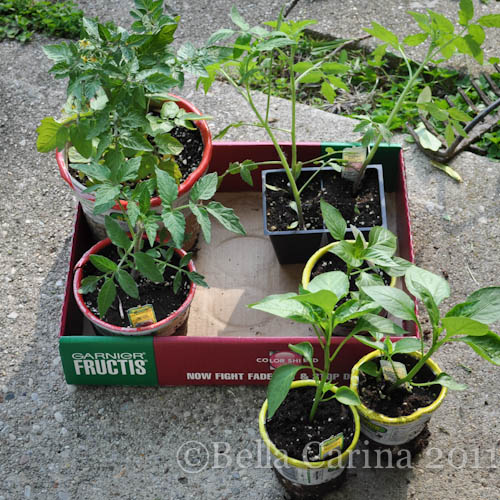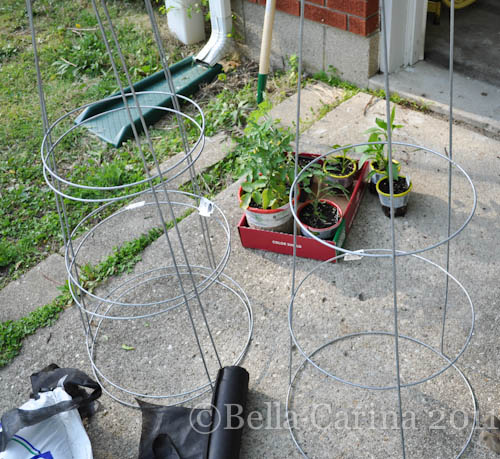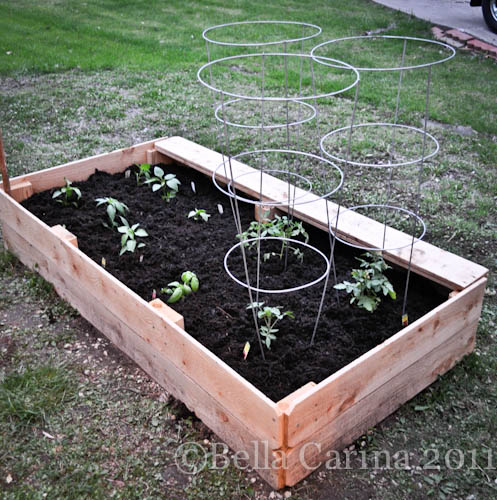So, now that your raised garden bed is all done and filled with soil, it’s time to plant! (If you missed the post on building the raised bed, you can check it out here.) Since Dane and I are not exactly expert gardeners, we wanted to plant things that are known to get good yields without too much expertise. I talked to my parents who used to have a pretty extensive vegetable garden in our backyard when I was growing up and they told me tomatoes, peppers, and basil are all pretty good starter plants. Which works out wonderfully for us since we like to eat all of those! If you go to your local Lowe’s or Home Depot, they usually carry plants that are appropriate to grow in whatever region you happen to be living in. That helps make it a little easier as well.
Now, if you are feeling adventurous, you might want to try growing your plants from seeds. I figured since this was our first garden attempt, I wanted to make it as fool-proof as possible. I mean, the plants’ likelihood of survival was already pretty slim with the two of us brown thumbs involved. 😉 This meant, using plants as opposed to seeds. I went to my local Home Depot and just picked the plants that I thought looked the healthiest. I didn’t choose any specific brand names or sizes, just picked plants that seemed healthy and thriving. Here’s a picture of some of the plants. See? Healthy and thriving, right?
 When it comes to buying tomatoes, I’m not going to pretend that I’m an expert, but I can give you some tips from my hours of internet research. If a plant is called an ‘heirloom’ then it means that it is a variety that has proven time and time again to be a good plant with high yields. Heirloom is good. Sometimes, a company will call a tomato their “best tomato.” This is also good and is similar to an heirloom in that it has been proven to be a good plant with high yields. Another term that is good to look for is “hybrid.” That means that some botanist people, much smarter than I am, grafted different kinds of tomatoes to create one that is good at stopping bugs and will produce a high yield, among other things. In case you aren’t sure, “high yield” just means that you’ll get lots of tomatoes…which is a good thing. 😉 From there, just choose the size of tomato that you like to eat. I went with a cherry tomato plant, a medium sized “best tomato” plant, and then another one that was medium to large. I wanted tomatoes that we could use for caprese and possibly pasta sauce. I’m not a fan of the huge “beefsteak” type tomatoes, but if you are into tomatoes on your burgers and whatnot, that might be a choice for you. Oh, and then be sure to buy a tomato cage for each tomato plant you purchase.
When it comes to buying tomatoes, I’m not going to pretend that I’m an expert, but I can give you some tips from my hours of internet research. If a plant is called an ‘heirloom’ then it means that it is a variety that has proven time and time again to be a good plant with high yields. Heirloom is good. Sometimes, a company will call a tomato their “best tomato.” This is also good and is similar to an heirloom in that it has been proven to be a good plant with high yields. Another term that is good to look for is “hybrid.” That means that some botanist people, much smarter than I am, grafted different kinds of tomatoes to create one that is good at stopping bugs and will produce a high yield, among other things. In case you aren’t sure, “high yield” just means that you’ll get lots of tomatoes…which is a good thing. 😉 From there, just choose the size of tomato that you like to eat. I went with a cherry tomato plant, a medium sized “best tomato” plant, and then another one that was medium to large. I wanted tomatoes that we could use for caprese and possibly pasta sauce. I’m not a fan of the huge “beefsteak” type tomatoes, but if you are into tomatoes on your burgers and whatnot, that might be a choice for you. Oh, and then be sure to buy a tomato cage for each tomato plant you purchase.
 Along with the tomato plants, I bought a sweet basil plant, and six different pepper plants (some hot and some sweet). When it comes to spacing and placement, you need to consider how big the plants will become. I knew that my tomato plants were going to get pretty large and I didn’t want them casting a shadow on my peppers, so I planted them at the northern end of my planter box. (Monitor the sun for a day to see where your tall plants should be planted to avoid casting a shadow on the little guys.) The tags for each plant should also tell you how much space they need. I laid all my plants out before I started planting just to get an idea of where everyone should end up.
Along with the tomato plants, I bought a sweet basil plant, and six different pepper plants (some hot and some sweet). When it comes to spacing and placement, you need to consider how big the plants will become. I knew that my tomato plants were going to get pretty large and I didn’t want them casting a shadow on my peppers, so I planted them at the northern end of my planter box. (Monitor the sun for a day to see where your tall plants should be planted to avoid casting a shadow on the little guys.) The tags for each plant should also tell you how much space they need. I laid all my plants out before I started planting just to get an idea of where everyone should end up.
 Here’s my three tomato plants and the basil. (I can tell you that the poor basil plant actually ended up being shaded a good portion of the time, and although it did ok, I probably should have planted it somewhere else.) The tomato plants should have at least 12-18 inches between plants. I’ve read that this is a little close, but we obviously had a limited amount of space and they seemed to do fine.
Here’s my three tomato plants and the basil. (I can tell you that the poor basil plant actually ended up being shaded a good portion of the time, and although it did ok, I probably should have planted it somewhere else.) The tomato plants should have at least 12-18 inches between plants. I’ve read that this is a little close, but we obviously had a limited amount of space and they seemed to do fine.
 And here’s my peppers planted in the southern end of the bed. They don’t need to be spaced out quite as much.
And here’s my peppers planted in the southern end of the bed. They don’t need to be spaced out quite as much.
 I forgot to tell you in the last post about purchasing soil, that you also need to buy mulch. Mulch is a great tool to use in your garden because it insulates the soil (as in, helps regulate the temperature) and also helps stop weeds from growing (yay, for less weeding!). The bags of mulch should tell you how much area it will cover by square foot. For reference, I bought two bags of black mulch (about $3 each) and only ended up using one bag for this bed. There are all kinds of different mulch you can buy from rubber to pine needles and all different colors. Of all the research I did on mulch, I never really got a definitive answer on whether or not one kind is better than the other, so I just went with the least expensive black organic one I could find. I think it’s more of a personal preference thing.
I forgot to tell you in the last post about purchasing soil, that you also need to buy mulch. Mulch is a great tool to use in your garden because it insulates the soil (as in, helps regulate the temperature) and also helps stop weeds from growing (yay, for less weeding!). The bags of mulch should tell you how much area it will cover by square foot. For reference, I bought two bags of black mulch (about $3 each) and only ended up using one bag for this bed. There are all kinds of different mulch you can buy from rubber to pine needles and all different colors. Of all the research I did on mulch, I never really got a definitive answer on whether or not one kind is better than the other, so I just went with the least expensive black organic one I could find. I think it’s more of a personal preference thing.
Once all your plants are planted, water the soil and then use a spade to apply the mulch on top of the soil. (In the photos above, I had already put the mulch down in case you were wondering.)
 Roman was there to supervise the process. 😉
Roman was there to supervise the process. 😉
 Here she is, all done. Isn’t it so pretty?
Here she is, all done. Isn’t it so pretty? Don’t forget to label all your plants. If you’re like me, then you are going to forget who’s who in the zoo. 😉
Don’t forget to label all your plants. If you’re like me, then you are going to forget who’s who in the zoo. 😉
 I wanted to make some of those cute plant markers using chalkboard paint and sticks, but never got around to it…maybe next year?
I wanted to make some of those cute plant markers using chalkboard paint and sticks, but never got around to it…maybe next year?
In Ohio, it rains…a lot, so I wasn’t sure how to go about watering my garden. Tomatoes like heat and water…but not too much water. Depending on where you live and how hot and dry it is, will change how much you’ll need to water your garden. My research suggested that it’s better to do one deep saturation watering a week as opposed to lightly watering your garden every day. Since it rains so often here, I would just let my plants tell me when it was time to water. If it hadn’t rained in a couple days and the leaves looked like they were a little wilted, I would do a deep saturation watering and they usually perked back up by the next day. That method seemed to work for me. I also think that the Moisture Control soil that we added in helped. It has little pellets mixed into it that retain and release water as needed. Now, if you live in a region that gets little rainfall if any in the summer, then you may need to water everyday.
I’ll be back soon with some pictures of how our garden fared and how we ended up modifying our garden bed when our fruit started turning up partially eaten all over the yard (!).
Anyone have any better tips on choosing tomato plants or when to water a garden? As I said, I’m pretty much a novice at all this. 

Pingback: ~ How to build a raised garden bed ~ | Bella Carina
Thank you for posting this! I can’t wait to build ours in the spring
can’t wait to hear how yours turned out
~karen
Pingback: Downsizing the Garden: Potted Vegetable Garden | Bella Carina